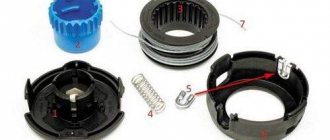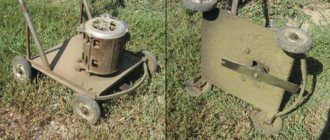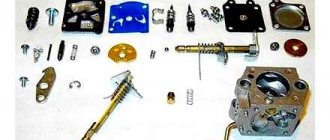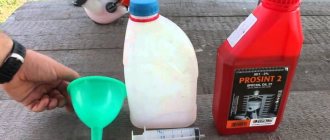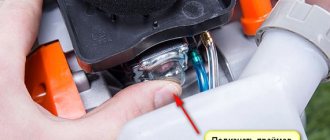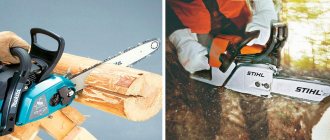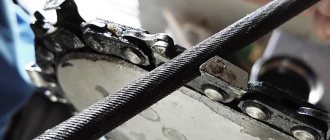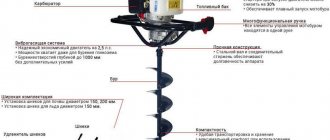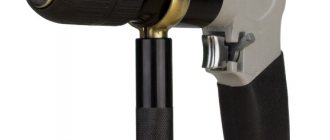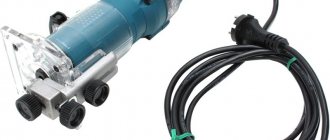Gasoline trimmer device
Numerous models of hand-held lawn mowers available on the market today differ in power (and, as a consequence, in their capabilities), weight, and the presence of certain additional functions that increase ease of use, but the basic design of the tool remains unchanged.
An internal combustion engine is used as a power drive in any gasoline trimmer. By means of a rigid or flexible shaft, the rotation from it is transmitted to the cutting element - a reel with cord (line) or a special knife. The shaft is placed inside a metal rod, at one end of which the engine and fuel tank are fixed, and at the other there is a cutting head.
A handle is attached to the middle part of the rod. Most often, it is on it that the keys, buttons and switches are located, with the help of which the operation of the trimmer is controlled.
The layout of the controls may vary slightly depending on the model of the tool, but, as a rule, this includes a button to turn off the engine, a “gas” button that allows you to control the carburetor throttle, and a stopper for this key when pressed, making it easier to control during large volumes of work.
1. Gearbox. 2. Trimmer head. 3. Protective cover. 4. Throttle lever stop button. 5. Switch.
6. Gas lever. 7. Handle. 8. Throttle lever stop. 9. Barbell. 10. Loop for attaching a belt carabiner.
11. Air filter. 12. Spark plug. 13. Engine housing. 14. Exhaust manifold. 15. Gas tank. 16. Starter.
Trimmer installation and repair
General design
The appearance of my electric scythe is shown in the photograph with explanations of the main components.
The technical characteristics of the ECO GT-800L trimmer are presented in a table from the instructions.
When I chose it, I focused on the power and engine speed. 800 watts is enough with a large margin. A fishing line with a diameter of 1.6 mm is quite enough for processing grass in the garden and lawns. You just shouldn't let it grow above your knees. Otherwise, you will have to mow in two stages, because the long stems begin to twist around the mowing head.
I showed the electric motor housing, the power button and the nameplate in close-up with a photograph.
Disassembly
All fastening screws are located on one side of the electric motor housing. It is convenient for disassembly.
After unscrewing the mounting screws, you must carefully separate the body halves with your fingers, overcoming the adhesive force of the plastic locks. In difficult places I used a flat-blade screwdriver.
I presented the general view of the electric motor after removing the top cover with a photograph.
Sequence of inspection of main components
Design flaws
Immediately during disassembly, a weak point was revealed - the attachment point of the plastic housing to the thin-walled rod pipe. A self-tapping screw with a large thread pitch is used. The socket immediately became loose and it was impossible to clamp the screw tightly: it rotated and cut soft metal.
Engine controls
The trimmer power button acts on the microswitch lever - the mic. The return occurs due to the force of the springs. In the photo I installed them incorrectly; I was shooting in a hurry and didn’t notice. The springs are completely located in the internal compartment of the housing.
To start the motor, the same principle is used as an electric drill. The work can be done in two ways:
- continuously holding the button pressed;
- using an additional clamp.
For safety reasons, I refused the second option and removed the retainer along with the spring. I believe that this mode should be used only for permanently mounted power tools, when cases of safety violations at home are excluded, and the electric motor does not require immediate stopping.
The bottom half of the photo showed more clearly the microphone button, which controls the operation of the electric motor.
The microswitch itself is conveniently placed in a separate compartment-socket, and its markings are shown below.
Engine commutator brushes and plates
Inspection did not reveal any obvious defects.
Minor contamination of the contact surfaces of the brushes and commutator plates is quite normal and corresponds to operating conditions.
Motor stator and rotor windings
All surfaces are intact, there are no mechanical damages or signs of overheating, no effects of temperature.
No damage to the paintwork is visible.
Motor wires and bearings
Everything is fine too. All structural elements are in working order, although slight contamination of individual parts and traces of corrosion have appeared on the magnetic circuit of the stator of the electric motor and metal parts.
By the way, I didn’t like the design of the bearings. The plastic parts don't inspire confidence. I compare it with the design of a 300-watt Soviet drill, which I used for about thirty years, intensively loading it with work on a homemade wood lathe, drilling holes in concrete with the consistent use of a bolt, and in other modes.
There metal bearings have never failed. From intense work, only the commutator and brushes gradually wore out.
Electrical checks of the trimmer motor
Preparing the circuit
A tester is required for this work. Disconnecting the electrical circuits on the trimmer is easy to do. The terminals on the motor, wires and microphone are the same type.
Checking the operation of the microswitch and its wires
Tester in Ohmmeter mode. The electric motor circuit was not understood. I placed the wire with the crocodile on a random contact of the power cord plug, and passed it with a homemade probe along the terminals of the microphone. The device showed different resistance readings.
It is already possible to make a preliminary conclusion that some of the wires are not broken, and the microphone is in the open position. When working, he turned on the engine. Let's check this moment.
The crocodile remains on the plug, I hold the probe on the contact of the microphone, which shows the gap, and close the contact by pressing the button. This is not easy to do, because you still have to photograph everything with one hand.
Turning on the button showed zero resistance, which indicates that the switch is working.
Checking the operating circuit of the trimmer motor
The tester remains in Ohmmeter mode. One of its terminals was connected using a clothespin to the second contact of the power plug, and the other through an alligator clip to the microswitch contact on the engine side.
The active resistance of the measured electrical circuit was 9 Ohms. Its value was determined:
- connecting wires;
- windings;
- contacts of brushes and commutator plates.
There was no obvious break in the circuit inside the electrical circuit. This is also evidenced by the fact that the trimmer was initially put into operation. But, something makes it turn off under load.
There are only two such switching devices with power contacts in the trimmer’s electrical circuit:
- microswitch, which we checked by continuity;
- thermostat.
In fact, the possibility that the microphone is disconnected from the load remains. But, knowing its structure and the fixation of the contact in the on state due to mechanical holding with fingers, we can safely assume that the reason does not lie in it. The second element with power contact remains.
Thermal relay
If you carefully examine the connection diagram of the windings, you will see that some small plastic box located on the winding is connected in series with one of them. One wire goes in and another comes out. On the case there is a marking and the inscription 110 degrees Celsius.
This is a protective relay that, at normal temperatures, keeps the power contact closed, and opens it at critical temperatures. I admit that something has broken inside it, it began to work incorrectly, the contact opens due to shaking.
I decided to take him out of work for the duration of the inspection. First, I removed a small section of insulation on its wires.
Then I simply twisted these wires together. I bypassed the disconnecting contact in this way. The engine temperature was controlled. Even without this, I periodically check it by touch. I never felt any heating. The power of 800 watts for cutting grass with a fishing line is more than enough even for a long time.
I wrapped a piece of old electrical tape around the shunt area and placed the thermal relay under the mounting tie, as before.
Assembling the circuit and closing the case
I assembled all the disconnected wires in reverse disassembly sequence. In such situations, I don’t rely on memory when dismantling mechanisms. For a long time I have been trying to sketch everything, draw up wiring or logical electrical diagrams. And with the advent of digital cameras, photographs help in this regard.
When assembling the case, before closing the top cover, you should check the laying of the wires and place them correctly between the compartments through the prepared grooves and recesses. Otherwise, you can squeeze and damage the insulation with sharp plastic edges.
Clicking the locks and screwing in the screws was not difficult. The trimmer is assembled. It will work without a thermostat. But this is a temporary phenomenon. I have already ordered this protection.
Deciding on the type of gasoline trimmer
All trimmers and lawn mowers available on the market today, depending on their capabilities and purpose, are divided into three classes: household, semi-professional and professional. What tool do you need? This depends primarily on the tasks that will be assigned to him.
Household petrol trimmers
Household trimmers are designed for mowing short grass in a relatively small area, the area of which does not exceed 10-15 acres. As a rule, we are talking about caring for the lawn near the house. They are not capable of more: household trimmers cannot withstand long-term operation, 1-1.5 hours a day is their limit. Thanks to the engine, which is modest in power (no more than 1-1.5 hp) and dimensions, such a tool is lightweight, which means it can be used without special support belts.
Often household trimmers are equipped with a curved rod. The curved shaft of the household trimmer increases its maneuverability and makes it easy to trim grass in hard-to-reach places, such as around bushes. However, due to this design of the rod, a flexible shaft is installed inside, which negatively affects the reliability of the tool. A cord (special fishing line) is usually used as the cutting element of a household trimmer, although some models sometimes include plastic knives as an addition.
Semi-professional, or farm
Semi-professional trimmers are often called farm trimmers, and this fully reflects their purpose. This is a reliable assistant for a rural resident, designed for regular high loads. Such a tool is capable of working for 3-4 hours a day, mowing grass on an area of 20-30 acres. Of course, such a trimmer needs a more powerful engine - 1.5-2.5 hp.
Semi-professional models, unlike household ones, are always equipped with a straight bar and a rigid shaft, which increases their reliability. The cutting part is represented not only by the trimmer head, but also by knives. The latter will help to mow especially tall and thick grass; moreover, they can even cope with weeds and branches of bushes.
Professional, or gardening
A professional trimmer is a powerful tool for urban improvement workers, landscaping companies and public utilities. It is equipped with an engine with a power of over 2.5 hp, has an increased service life and is ready for long hours of daily work. In addition to the trimmer head, such units can be equipped with metal knives that can cope with dense bushes and unnecessary shoots of trees with a trunk thickness of up to 3 cm in diameter.
It’s easy to guess that professional trimmers have a reinforced shaft and a spacious fuel tank. Since such tools are quite massive, they are necessarily equipped with special belts that lighten the load on the operator’s hands, and a professional vibration damping system. It is clear that purchasing a professional trimmer for cutting the lawn next to a private home is simply impractical.
Oil for gasoline trimmers: types and recommendations for use
Gasoline trimmers are one of the most popular devices for cutting grass. They are easy to use, mobile, allow a person not to depend on an outlet and show excellent results in the places where they are used. But for stable operation of a gasoline trimmer, high-quality consumables are required. In particular, we are talking about gasoline and oil. It is the last component that we will talk about in this article.
Gasoline engine type
Gasoline trimmers are equipped with both two-stroke and four-stroke engines. It cannot be said that this or that variety has clear advantages. At least, there is no direct connection between the type of engine and its power - there are both household models with a four-stroke engine, and professional ones with a two-stroke engine.
2 stroke engine
Compared to four-stroke engines, two-stroke engines, being lighter, operate in a higher speed range, which provides greater performance. Of course, two-stroke engines “eat” more fuel and produce a lot of noise and exhaust, but at the same time they impress with their unpretentiousness in operation. Each time you work with a trimmer equipped with a two-stroke engine, you will have to start by preparing a gasoline-oil mixture, but if such an engine suddenly fails, it will most likely not be difficult for you to revive it.
4 stroke engine
Four-stroke engines are free from almost all the disadvantages of two-stroke engines: during operation they produce much less noise, their exhaust gas volume is significantly lower, and gasoline and engine oil are poured into different containers.
They are more economical in terms of fuel consumption and have a longer service life. All this, however, does not mean that four-stroke internal combustion engines are ideal. No, they have their drawbacks.
The design of such an engine is more complex, which means that its maintenance and repair are more difficult. A four-stroke will always be heavier than a two-stroke of equal power, which negatively affects the weight of the entire tool and, consequently, the ease of handling it. And finally, a trimmer equipped with a four-stroke engine will be more expensive than the same one, but with a two-stroke internal combustion engine.
It should be mentioned that, along with classic four-stroke engines, there are also hybrid ones: their operating cycle occurs in 4 strokes, but the lubrication system is the same as that of a regular two-stroke engine.
Tips for choosing
Now let's try to understand how to choose high-quality oil for a trimmer running on gasoline. The main feature that you need to pay attention to will be the alkalinity number. This moment eliminates the oxidation of parts that experience friction and slows down their deformation as much as possible. The more this compound is used, the faster it loses alkalinity and becomes more oxidized. The optimal acidity indicator (PH) is a value of at least 8-9 units.
The second important factor, which also has a serious impact on the operation of a gasoline trimmer, is the viscosity of the oil. This characteristic determines the ability to use the device at different temperatures. Summer brands of oils begin to thicken even with a minimal drop in temperature.
But given that such trimmers are usually used in autumn and spring, it would be best to use oil with summer markings.
The third point, the importance of which should not be underestimated, is the flash point. This indicator should not be less than 225 degrees. Otherwise, the composition will burn out very quickly and the load on the piston group will begin to increase, which will cause its accelerated wear. In addition, oil for a 4-stroke engine is not suitable for a 2-stroke engine. Namely, the latter type of motor is used in the vast majority of gas mowers.
If we talk about manufacturers, we can create a small rating that will allow you to navigate the compositions offered by various manufacturers. For example, Stihl offers high-quality synthetic and mineral oils that have already proven themselves to be an excellent solution at any time of the year.
is considered very good . Experts note its high characteristics and excellent alkalinity and viscosity. In addition, products from brands such as Oleo Mac, Motul, Hammerflex, Echo . If we talk about products of domestic brands, then you should pay attention to Lukoil oil . Its price is several times lower than its foreign analogues, but at the same time it has high quality and good technical characteristics.
In general, the ideal solution would be synthetic or semi-synthetic oil labeled TV or TA.
Engine starting system
The engines of most gasoline trimmers are started manually: by sharply pulling the cable (starter cord), you thereby spin the drum, which in turn drives the engine crankshaft.
Some modern trimmer models are equipped with a Flash Starter easy-start system. By pulling the cable, you cock a special spring in several stages, which, having accumulated energy, transfers it to the crankshaft, which will be the impetus for starting the engine. With the Flash Starter system, the engine starts easier, because the spring gives a higher spin-up speed than can be done by hand. The operator now requires less physical effort, because he no longer needs to make sharp jerks on the cord; the cable can be pulled quite slowly and smoothly.
How to easily start a gas trimmer, watch the video:
To make it easier to start the engine, the power unit of the tool usually has a special button, several presses of which before starting will ensure that the required amount of fuel is supplied to the carburetor.
Electric trimmers
| ADVANTAGES | FLAWS |
| Significantly more affordable compared to gasoline | Loses to gasoline engines in terms of power |
| More comfortable to work with: they make less noise and vibrate less | Depends on the electrical network, requires a stationary power source or a generator |
| Clean tool, does not require refilling with fuel mixture | Operating area limited by cord length |
| There are no harmful emissions, so can be used near the home, playgrounds, and in confined spaces | Requires frequent stops to cool the engine |
| Low maintenance, easy to put into operation | There are restrictions for models with a lower engine; they cannot be used on wet grass. |
Tool power
How to choose a gasoline trimmer for cutting grass in your garden? And for cultivating a “plantation” of a couple of hectares? That's right, focusing on its power.
The power of the gasoline engine installed on trimmers can vary from 1 to 3-3.5 hp. The choice of tool for this parameter directly depends on the expected load. It is the power of the trimmer that determines its operational purpose. So, to mow the lawn next to the house, a simple tool with a power of no more than 1.5 liters will be enough. With. Farm trimmers are equipped with a more powerful engine – from 1.5 to 2.5 liters. With. The full range of capabilities of trimmers can only be demonstrated by a professional tool with a power of over 2.5 hp.
It is clear that an increase in the power of a tool inevitably entails an increase in its weight and cost. It follows from this that when choosing, you do not need to mindlessly chase high power indicators, but focus primarily on the planned scope of application of the tool.
How the Rod on the Patriot Petrol Trimmer Is Designed
Trimmer "Patriot" petrol. Reviews, prices, repairs
If you are the owner of a summer cottage with a lawn, then you probably cannot imagine the territory without periodic cutting of the grass, as well as shrubs. If this is not done, then unkempt vegetation in just one season will turn the dacha into a wasteland overgrown with weeds.
Content
Need for use
It will be possible to cope with such work with the help of an ordinary scythe, but it is quite rare today to meet a person who has retained the ability to use it. It is much easier to manage with a trimmer, which is a descendant of the above-mentioned tool.
If we are talking about a summer cottage, then it will be most convenient to purchase a gasoline model, since in such conditions it is not always possible to carry out electricity, and long wires will interfere with work. All that remains is to decide which trimmer option to prefer. Consumer reviews will help you with this.
How to choose
First of all, you need to decide what types of work are supposed to be carried out. For example, in some cases there is a need to mow only the grass of other owners of country houses on the territory. There are many young bushes, and powerful weeds appear quite often. If from time to time you fight with tree growth, then you will need a more powerful model.
Reviews about motors
The Patriot petrol trimmer is now available for sale in a wide range. Before purchasing, it is important to determine which engine best suit your needs. Most often, the mentioned manufacturer installs single-cylinder two-stroke engines in gasoline trimmers; their power can vary from 0.5 to 3.3 kilowatts. According to users, for the smooth operation of the engine it will be necessary to prepare a fuel mixture, which consists of a special oil for such engines and AI-92 gasoline. It is unacceptable to use a different brand of gasoline or a different type of fuel, as the engine may begin to operate unevenly and overheat.
READ How to Wind a Patriot Trimmer Coil
If you are interested in the Patriot gasoline trimmer, but you do not have the skills to work with the engines described above, then it is best to purchase a model that runs on a four-stroke engine. A distinctive feature of such units is that there is no need to pre-prepare the mixture. The technician will need to pour oil and gasoline into separate containers.
Solving complex problems
Buyers claim that four-stroke models are more powerful, so with equipment equipped with them, you can carve difficult, brushy areas. If you periodically face the task of mowing the lawn, but no more, then this power will be too much. In this case, experienced summer residents advise choosing units with two-stroke engines, which are lighter and cheaper.
Review of Patriot petrol trimmers Promo series
.
PATRIOT PT555 petrol trimmer
PATRIOTPT555 Review, operation of the PATRIOT gas trimmer
PT555, your observations and advice!
Reviews about the structure of the bar
The " Patriot " petrol trimmer is produced by the manufacturer in different variations, this also applies to the structure of the rod. This element acts as a conductor that connects the cutting system to the motor. Inside the rod there is a shaft, which can be flexible or straight. This indicates that the shape of the bar can be curved or straight. The latter option, according to users, is more durable and reliable. However, owners of areas with many hard-to-reach places and hills most often choose models with curved rods.
Experts advise paying special attention to whether the bar collapsible. If so, you can easily fold it for storage.
READ How to properly put fishing line on a patriot trimmer
Reviews of devices to lighten the load
The gasoline trimmer "Patriot" is undoubtedly capable of making lawn care easier, but mowing work cannot be called an easy process, since the operating unit creates vibrations. Therefore, it is sometimes quite difficult for a master to hold the instrument in his hands. If we add here the impressive weight, then for an unprofessional summer resident the process can end with pain not only in the back, but also in the arms.
The manufacturer made sure that the load created by the tool is distributed evenly across the body. There is a belt attachment for this. You must decide which trimmer model to choose based on this attachment.
If you decide to choose the Patriot gasoline trimmer, reviews of which are presented in the article, and want to save money, then it is best to purchase the option equipped with one belt that can be thrown over the shoulder. But then the load will fall on only one half of the body. As users emphasize, this can cause shoulder pain.
Experts advise purchasing the best option, which is represented by a double belt with shoulder pads. These elements are made of soft material. Users who want to protect themselves from unit vibrations also choose models with a hip pad. The Patriot gasoline trimmer, which has positive reviews, can also have a backpack suspension; this option is the most effective, but it is also quite expensive. Using such equipment, you can feel for yourself how evenly the load is distributed. This type of equipment can be adjusted to suit any figure.
Price
The gasoline trimmer "Patriot-3355" is a fairly common model. You will have to pay 7,000 rubles for it. The quality is confirmed by a long-term manufacturer’s warranty, which is 3 years, provided that the equipment is inspected at a service center every six months. Otherwise, the warranty will be valid for 1 year. This tool can be used to mow grass around bushes, trees, as well as near fences and fences. You can also take care of your lawn in areas with uneven terrain.
READ Trimmer Petrol Patriot Starts Poorly
You can store the equipment even in a small room, because it is equipped with a detachable rod. Long-term operation will be ensured by a shoulder strap.
Another model of the manufacturer is PT 555, the cost of which is 9,800 rubles. The Patriot trimmer, whose price is quite reasonable, mows grass using a fishing line, and with a knife you can trim small bushes, as well as tough grass. The equipment is equipped with a bicycle handle, which guarantees ease of control, and the trigger locking function will protect against accidental pressing.
Trimmer repair
The Patriot trimmer, which must be repaired in a service workshop, may fail during operation. If the warranty period has already passed, then you can try to fix the problem yourself. Most often, users are faced with the fact that the engine stops starting. The reason for this may be contamination of the fuel filter in the tank; if such problems occur, it is necessary to check its condition. If necessary, you can replace this element. Under no circumstances should the inlet pipe be left without a fuel filter.
Patriot trimmer , which you can repair yourself, sometimes needs to check the air filter. If it becomes dirty, the engine can be removed in the field, the spare part can be washed in gasoline and reinstalled. Spare parts for Patriot gasoline trimmers can be purchased at service centers.
Petrol trimmer rod and shaft
The trimmer rod, inside of which there is a shaft that transmits rotation from the engine to the working head, can be either straight or curved. The first is more reliable, the second is more ergonomic. Straight rods are installed on professional and semi-professional tools. The transmission shaft located inside such a rod is a rigid rod made of especially strong steel. The risk of damage to such a shaft, even under significant loads, is small.
Hard shaft.
Straight rod.
On petrol trimmers with a rigid shaft, the torque from the shaft to the cutting equipment is transmitted through a gearbox with bevel gears. Gearboxes can be serviced or not serviced. The gearbox being serviced has a technological hole through which lubricant can be replaced or added. In unmaintained units, lubricant is provided by the manufacturer for the entire service life.
Some users believe that a maintenance-free gearbox is less durable. In turn, manufacturers note that this step is aimed at increasing the service life of the gearbox, since according to statistics, very often gearboxes fail due to incorrect dosage of lubricant or foreign objects entering during maintenance.
The curved shaft is typical of lightweight residential trimmers. It is more convenient to use a tool with a curved shaft to trim the grass in the immediate vicinity of bushes and trees, benches, fences, etc.
The downside of this convenience is the lower reliability of such tools. The fact is that in this case it is possible to transmit rotation from the engine to the cutting element only through a flexible drive, and the latter is more vulnerable than a rigid shaft, and the likelihood of its failure is much higher.
Flexible shaft.
Curved rod.
The gas trimmer rod can be solid or collapsible. A solid transmission shaft (and this is a guarantee of reliability) can only be installed in a solid rod. But transporting and even simply storing such a tool is less convenient. A collapsible rod, consisting of two or more sections, on the contrary, ensures compactness during transportation and storage.
The disadvantage of detachable rods is obvious: the transmission shaft must also be disconnected, and any drive connection is an additional weak point. In addition, during disassembly, earth, sand and other debris can get inside the rod, which leads to premature wear of the working elements.
Handle type
Filigree control of a rather heavy unit is not as simple as it might seem at first glance. When choosing a trimmer, special attention should be paid to the configuration of the handle, on which the ease of use of the tool directly depends. There are several types of handles:
T-shaped handle , which looks like a bicycle handlebar, allows for wide movements and is convenient for quite long work, so it can often be seen on professional and semi-professional trimmers. All tool controls (starting, speed control, etc.) are located directly on one of the handles, which greatly simplifies work and increases safety.
The J-shaped handle is typical for lightweight household-grade trimmers. With its help, it is easier to control the tool, performing fine maneuvering. All the buttons necessary for the operator are located not on the handle, but on the rod.
D - shaped handle , as well as J-shaped, is installed only on lightweight trimmers intended for home use, since it is designed to hold the tool with one hand.
Before choosing a gasoline lawn mower, the future user must hold it in his hands and evaluate the degree of convenience. It should be borne in mind that any type of handle can be moved along the bar, adjusting the tool to your height and other individual characteristics and thereby achieving maximum ergonomics. Petrol trimmers with D and J-shaped handles are convenient to work in cramped conditions and narrow passages, which are often found in personal plots.
Belt system
Only a good shoulder strap can reduce the load on the hands when working with fairly heavy hand tools, redistributing part of the weight to the operator’s back and shoulders.
Shoulder strap system. For comfortable use of a relatively lightweight household trimmer, a simple one-shoulder belt is enough. If you have to work with a semi-professional or professional-class brush cutter, we strongly recommend that you look for products with two-shoulder belts.
Although backpack-type belt systems
Such backpacks are often equipped with special bags for storing cutting equipment, as well as tools that may be needed to repair the trimmer in the field. And a special pad that manufacturers supply to the belt system protects the operator’s thigh from burns when it comes into contact with an engine that is very hot during operation and reduces the level of transmitted vibration.
Additional amenities
Availability of anti-vibration system
During operation of the trimmer, vibrations occur, which is generally typical for any mechanism, the individual elements of which perform rapid reciprocating movements. Vibrations can cause the operator to experience noticeable discomfort while working, and frequent use of the tool can cause health problems, the most predictable of which is premature wear of the elbow joints.
A special anti-vibration system will help to significantly reduce the vibration impact on the body of a person working with a trimmer. In the simplest and most common version, it is a set of polymer gaskets located between different structural elements of the trimmer.
Anti-vibration system for lawn mowers.
Such gaskets reduce the transmission of vibration and thereby ensure normal working conditions for the user with the tool. To dampen vibrations, manufacturers often additionally separate the engine from the boom with special shock absorbers. Today, almost all the world's leading brands equip their products with an anti-vibration system.
Fuel tank volume
The capacity of the fuel mixture tank can vary from 0.3 to 1 liter depending on the model. Which trimmer with which gas tank – large or small – should you prefer? Both options have their advantages and disadvantages. A large-capacity tank increases the weight of an already heavy unit, but does not require frequent stops for refueling.
A tank of smaller capacity, in turn, is smaller and heavier, contributing to more economical fuel consumption, but at the same time does not allow long-term non-stop operation. When choosing a trimmer based on such a parameter as the volume of the fuel tank, you should focus on your physical abilities and the size of the area that you will regularly mow. It is very convenient if the fuel container is made of translucent plastic - this allows you to monitor the amount of fuel remaining in it during work.
Device weight
The convenience of working with a trimmer directly depends on its weight, because the entire load falls on the hands and shoulders of the person performing the operation. If the tool turns out to be too heavy for you, then no matter how powerful it is and no matter how well it mows the grass, the end result is unlikely to be satisfactory: you simply will not be able to work with it for a long time and control it delicately when getting to hard-to-reach areas.
That is why, when choosing a trimmer, you should definitely pay attention to the weight of the device, especially if you yourself cannot boast of heroic strength. Don't chase power. In many cases, it is more rational to purchase a less powerful, but at the same time lighter unit: you will spend a little more time mowing your plot, but you will not get so tired that you quit the job without finishing it.
Let's start running in the lawn mower
After starting, do not rush to immediately break in the trimmer. Allow the engine to warm up at idle speed for 5 minutes. While warming up, adjust the air supply using the air damper lever so that the spool with fishing line or knife does not rotate. As soon as the tool has warmed up, we fully open the air supply by moving the corresponding lever to the “ON” position and squeeze the gas trigger 1/2 and hold for 20...30 seconds. Then we let off the gas and let the trimmer work for XX 30..40 seconds. We continue in this mode for 10…15 minutes. Then turn it off and let it rest for 15...20 minutes.
Having cooled the lawn mower, we continue to run in the engine according to the previous scheme. You need to start the trimmer when it’s hot, with the air damper already open. Try not to hold the gas for a long time, since the moving parts of the tool are only rubbing against each other. And do not let the engine idle for too long, as it may overheat.
The next stage is running in the gas scythe gearbox. To do this, you need to choose an area with soft young grass. We mow for 5...10 minutes with throttle adjustments at 1/2...2/3 of full throttle. Afterwards we take a break for 20…25 minutes. We repeat the cycle 3…4 times.
In general, running in the lawn mower according to the described algorithm is carried out until the fuel mixture in the tank is completely exhausted. After which the tool is ready for long-term work. During operation, monitor the temperature conditions of the gearbox and motor. They should not overheat.
Source
What you need to know about work equipment
The working element of a brush cutter that directly cuts off excess vegetation can be either a cord (special cutting line) or knives. These are consumables, even if they are included in the factory kit of the tool, over time they will have to be purchased and replaced. The choice of equipment used depends on the tasks that you plan to solve with your trimmer, and primarily on the thickness and density of the grass that will be mowed.
Trimmer head
Almost all trimmers are equipped with a trimmer head - a reel designed for winding cutting line. According to the method of feeding the line, all trimmer heads are divided into mechanical (you have to manually pull out the ends of the line yourself), semi-automatic (the line is released when you press a wide button on the bottom plane) or automatic (the protruding ends of the line are lengthened automatically when the engine speed decreases). Semi-automatic cord feeding is considered the most effective; such heads are most popular among users.
In addition, trimmer heads may differ in the maximum permissible diameter of the mowing line that can be threaded into the reel. Household trimmers usually use a line with a diameter of 2 to 2.4 mm, semi-professional trimmers - from 2.4 to 2.7 mm, professional trimmers - from 2.7 to 3 mm.
When choosing a trimmer head, be sure to pay attention to the material from which the lower part is made. It is this part that is the most vulnerable, since it constantly collides with the ground, and it is this part that most often causes the trimmer head to fail.
Knives
To mow particularly thick grass, reeds, bushes, and young trees, they use special knives (cutters) rather than a fishing line. On sale you can find a huge number of varieties of knives for trimmers, differing in material (metal or plastic), shape, and number of cutting blades. By the way, cutters, unlike fishing lines, do not chop up grass, which means they can be used for mowing for harvesting purposes.
Which knife should you choose for your trimmer? When solving this issue, you should first of all focus on the manufacturer’s recommendations, indicating the possibility of using one or another type of equipment on this model. Excessive independence in choosing knives and cutters can lead to trimmer failure.
